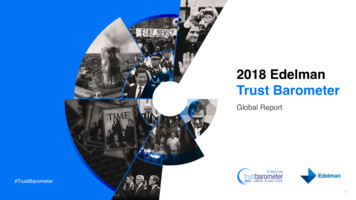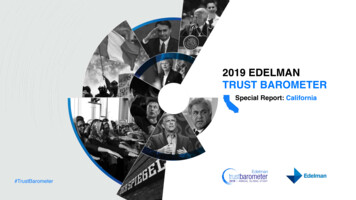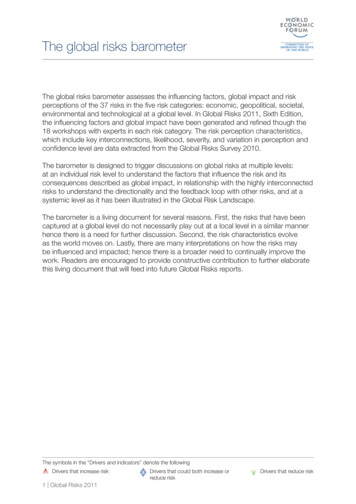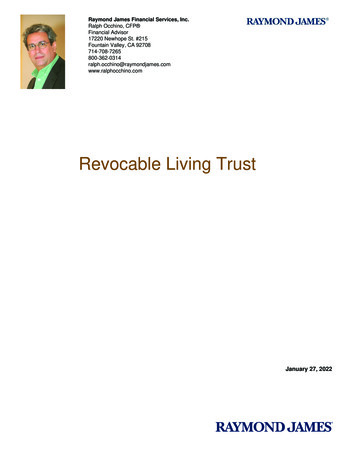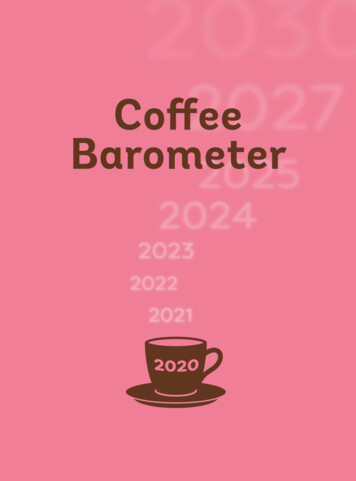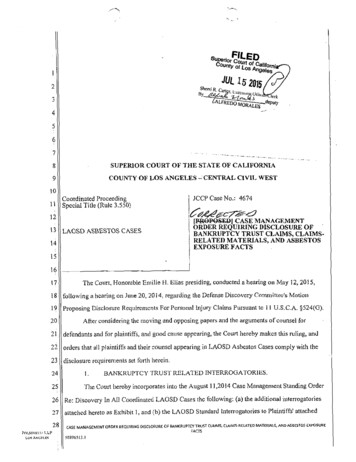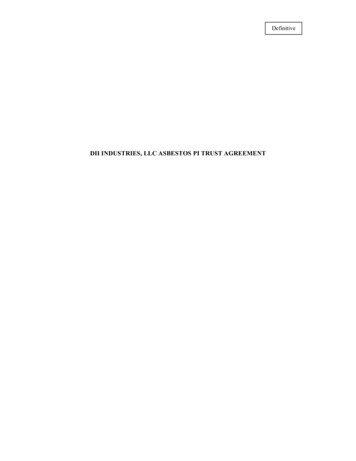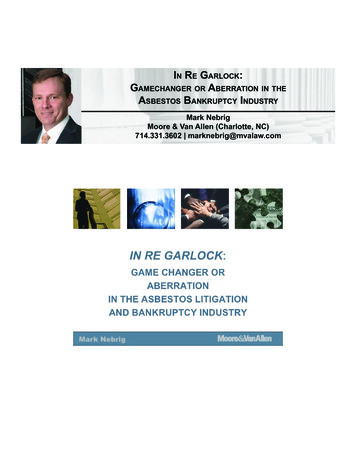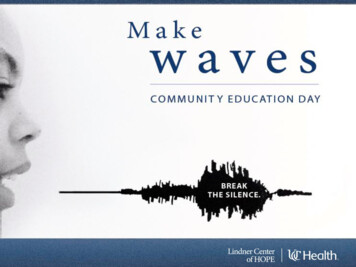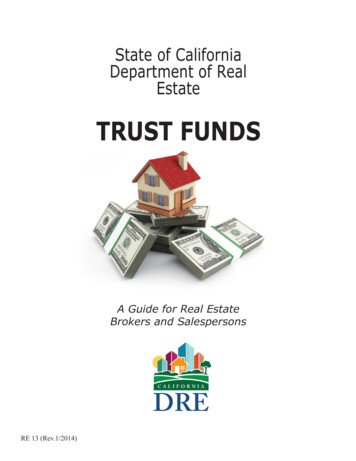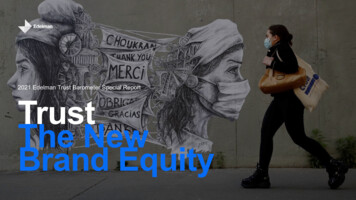
Transcription
2021 Edelman Trust Barometer Special ReportTrustThe NewBrand Equity
5 years of trust research:Growing demands on brands20172018201920202021Rise of Beliefdriven BuyingBrand Democracy:Voting With My WalletBrand Trust a TopBuying CriteriaBrands Expected toSolve PandemicProblemsTrust, the NewBrand Equity2
SEISMIC SHIFT IN VALUES2020 Edelman Trust Barometer Special Report: Brands Amidst Crisis2021 Edelman Trust Barometer Global ReportPandemic ChangesBrand Buying CriteriaOnly Business Seen as BothCompetent and EthicalNet change in importance as a buying criteriaEthicalMatter moreValue, customer safety, and people 37BusinessLessCompetentMatter lessMy image, trendiness, 2020 Edelman Trust Barometer Special Report: Brands Amidst Crisis. IMP COV. For each of the following purchasing considerations, please indicate whether it has become more important to you, less important to you, or hasstayed the same in importance, as a direct result of the COVID-19 pandemic. 3-point scale; code 1, more important; code 2, less important. General population, 8-mkt avg. Data is the difference between more important and lessimportant. “Value, customer safety, and people” is a net of attributes 17, 29, 33; “Image, trendiness, and excitement” is a net of attributes 6, 9, 10. 2021 Edelman Trust Barometer. The ethical scores are averages of nets based onINS PER DIM/1-4. Question asked of half of the sample. The competence score is a net based on TRU 3D INS/1. Depending on the question it was either asked of the full of half the sample. General population, 24-mkt avg. Data notcollected in China, Russia and Thailand. For full details regarding how this data was calculated and plotted please refer to the Technical Appendix.3
A BROADER DEFINITION OF BRAND RELEVANCEThen Now Brand relevance limitedto cultural relevanceCulture, purpose, andsociety all matter to ietycompaniesgovernmentPurposeSociety4
2021 Edelman Trust Barometer Special ReportTrustThe NewBrand Equity14-market online surveyReport includes findings from:2021 Edelman Trust Management: Brand TrackerBrazil, Canada, China, France, Germany, India, Japan,Mexico, Saudi Arabia, S. Africa, S. Korea, UAE, UK and U.S.7-market tracking survey of 115 brands All data is nationally representative based on age, region, genderand additionally in the UK and U.S. by race/ethnicity 7,350 respondents (1,050 per market) 14,000 respondents (1,000 per market)Timing of Fieldwork: May 12 – June 2, 2021Margin of error: 14-market average data /- 0.8% (n 14,000), Market-specific data /- 3.1% (n 1,000) China, France, Germany, India, Japan, UK, and U.S. Respondents rate up to 10 brands out of70 brands in each marketTiming of Fieldwork: Eight waves betweenAugust 14, 2020, and May 30, 20215
Brands mustwork to changethe world.6
BRAND TRUST MATTERSMORE THAN LOVEPercent who rate each as critical or importantwhen deciding which brands to buy or useTotalimportanceCritical dealbreakerIt offers a good value for the money8936It offers the best quality8933I trust it8832It offers high quality customer service8528It is convenient to find, buy and use8526It has a good reputation8426I love it81262021 Edelman Trust Barometer Special Report: Trust, The New Brand Equity. TRUST IMP. When it comes to brands in general that you will or will not buy or use, categorize each of the followingattributes based on whether it is a critical deal breaker, important to have, or merely a nice to have. 3-point scale; code 1, deal breaker; code 2, important. General population, 14-mkt avg. Data on the leftis a sum of codes 1 and 2.7
TRUST IN BRANDS NOW MORE IMPORTANTPercent who sayBrand trust matters more across demographics—but especially for younger consumers68%It is more importantfor me to be able to trustthe brands I buy or usetoday than in the past75Age 18-3469Age 35-542021 Edelman Trust Barometer Special Report: Trust, The New Brand Equity. IMP TRU. Is it more important to you to be able to trust the brands you buy or use today than it was in the past?Question asked of those who said it’s at least a little important to be able to trust the brands they buy or use (Q100/2-5). General population, 14-mkt. avg., and by age.59Age 55 8
DEEPER DEPENDENCE ON BRANDSINCREASES NEED FOR TRUSTReasons why it is more important to trust the brands theybuy today than in the past43Trust more important in all aspects of my life36Brands’ increasing impact on the environmentIncreased reliance on brands to keep me safe in pandemicBrands’ impact on the economic recovery32312021 Edelman Trust Barometer Special Report: Trust, The New Brand Equity. IMP WHY. You just indicated that it is more important to you to be able to trust the brands you buy today than in thepast. Among the items listed below, please select those, if any, that best describe why it has become more important to you to be able to trust brands. Pick all that apply. Question asked of those that say itis more important to be able to trust the brands they buy or use today than in the past (IMP TRU/1). General population, 14-mkt avg.9
BRANDS EXPECTED TO ACTBEYOND THEIR BUSINESSActions consumers expectfrom the brands they buy:86%Expect brands to takeone or more actionsbeyond their productand businessGive money to good causesTell hard truthsAddress societal challengesSupport local communitiesCreate positive change in societyAddress political issuesDisplay representative imagesSupport culture and the artsMake our culture more acceptingNo support for misinformation2021 Edelman Trust Barometer Special Report: Trust, The New Brand Equity. EXPECT. When it comes to thinking and acting beyond their products and business, what do you expect from the brandsyou buy? Pick all that apply. General population, 14-mkt avg. Data shown is a net of attributes 1-10.10
TODAY, PEOPLE ARE MORE FOCUSEDON THE “WE” THAN THE “ME”I am more attracted to Brands that focus on makingthe world a better place6337Brands that focus on makingme a better person2021 Edelman Trust Barometer Special Report: Trust, The New Brand Equity. ATTRACT. You are about to see two choices. Please pick the one that better describes the type of images, messages,people and brands that you are more attracted to, or that you find more appealing, these days. General population, 14-mkt avg.11
BRAND RELEVANCE NOWFAVORS “WE” VALUESPercent who say each action wouldmake a brand culturally relevantReflect societal values38Meet a new societal needChange social interactions for the better3332Part of my life since childhood30Matches my humor30Represents my lifestyle“We”values“Me”values292021 Edelman Trust Barometer Special Report: Trust, The New Brand Equity. CULT REL. Companies strive to make their brands as relevant as possible to consumers as a way of increasing thelikelihood that people will be attracted to them. One form of relevance that some brands try to achieve is cultural relevance. What would make a brand culturally relevant to you? Pick all that apply. Generalpopulation, 14-mkt avg. “All of the above” added to each response.12
2021 Edelman Trust Management Brand TrackerCHANGING CULTURE MOST POWERFULWAY TO EARN BRAND TRUSTEdelman Brand Trust Scorefor brands seen as 38(7-market average)Trust lift 255265Changing culture improves a brand’sperformance across all five trust-buildingdimensions, when compared to brands that focusonly on product functionality (percent lift):ptsptsfor brands27Purpose 62%Self 58%Dependability 51%FunctionalReflectingChangingonlyour cultureour cultureIntegrity 56%Ability 45%2021 Edelman Trust Management: Brand Tracker. ETMB21. Which of the following best describes [BRAND]? 9-point scale; top 3 box, high trusters; bottom 4 box, distrusters. General population, 7-mktavg. Data shown is an EBTS score that ranges from -100 to 100. The EBTS is calculated by subtracting distrusters from high trusters. Data for this wave was fielded from May 20 to May 30, 2021. Fordetails about how the five dimensions are measured and more information on how the trust scores are calculated please refer to the Technical Appendix. Brand trust increases shown are percentincreases in brand dimension.13
Trust is the newbrand equity.14
NEARLY 2 IN 3 CONSUMERS BELIEVE THEYHAVE THE POWER TO FORCE BRANDS TO CHANGEWhich do you see as the balance of power?Consumers can get abrand to change almostanything about itself6337Consumers cannotforce brands to change2021 Edelman Trust Barometer Special Report: Trust, The New Brand Equity. BRD CHOICE4. You are about to see a series of two choices. We want you to choose the one that best describes whatyou see as the balance of power in the marketplace. General population, 14-mkt avg.15
CONSUMERS WANT TO USE THEIRBRAND POWER TO MAKE SOCIETY BETTERConsumers believe theycan force brands to:78%I can force brands tochange its company’ssocietal impact (net)Use environmentally-friendly materials 39Reduce carbon footprint 37Pay fair share of taxes 33Increase workforce diversity 32Get CEO to speak out 27Improve labor practices 38Manufacture products in this country 31Get rid of CEO 252021 Edelman Trust Barometer Special Report: Trust, The New Brand Equity. BRD IMP. If a large group of consumers put pressure on a brand, which of the followingdo you think they could force the brand to do? Pick all that apply. Question asked of half of the sample. General population, 14-mkt avg. “All of the above” added to eachresponse. Data on the left is a net of attributes 3, 4, 5, 7, 8, 9, 10, 12.16
CONSUMERS WILL GIVE UP BRANDS THEY LOVEIF THEY DON’T TRUST THE COMPANYPercent who agreeHigh-income consumers even more likely toswitch when they don’t trust the company40%There are brands I lovebut no longer buy becauseI do not trust the companythat owns the brand31Low income40Middle income2021 Edelman Trust Barometer Special Report: Trust, The New Brand Equity. CORP BRD. Individual product brands are often produced by big corporations that own many different brands. When itcomes to product brands versus the corporations that own them, please indicate how much you agree or disagree with the following statements. 9-point scale; top 4 box, agree. General population, 14-mktavg., and by income.50High income17
2021 Edelman Trust Management Brand TrackerCONSUMERS WILL BUY BRANDS THEY TRUSTPercent who are likely to buy the brand in the future, comparing those whohave high trust in the brand to those who distrust the brandHigh trustersMultiplier(likelihood tobuy among hightrusters rmany6388FranceJapan2021 Edelman Trust Management: Brand Tracker. ETMB13. How likely are you to buy/use the products and services of the following brands in the future? 7-point scale; top 2 box, more likely topurchase. EBTS1. Please indicate how much you trust each brand. 9-point scale; top 3 box, high trusters; bottom 4 box, distrusters. General population, 7-mkt avg. Data shown is an aggregate from 70brand ratings in each market across five waves in 2021 (January to May 2021). For details about how this data is collected and measured please refer to the Technical Appendix.18
A new playbookfor brands.19
BUSINESS INTEGRITYFOUNDATIONAL TO BRAND TRUSTTop 2 issues that business sectors must speak out on or risk losing trust, based onthe average ranking of each issue within each market, demographic and Workers’ rights and paying a living wage#1#1#1Safely re-opening the economy#2#2#22021 Edelman Trust Barometer Special Report: Trust, The New Brand Equity. SECTOR. Please indicate which of the following issues the [SECTOR] industry/business sector must publicly speak outon or risk losing your trust. Pick all that apply. Industries shown to half of the sample. General population, 14-mkt avg. “All of the above” added to each response. Data is showing the ranking of both issuesacross all markets, demographics, and sectors. For full details regarding how this data was calculated please refer to the Technical Appendix.20
BEYOND THE FUNDAMENTALS,ADDRESS WHAT MATTERS LOCALLYUKU.S.211Taking actions to combat climate changeand environmental degradation2212112Alleviating poverty and helping the poor2Improving access to healthcare1211121Protecting human rights worldwideImproving people’s diet and nutritionPromoting gender equalityEnding racismUAE2S. KoreaMexico1S. AfricaJapan2IndiaGermany1China1CanadaMaking companies pay their fair share of taxesBrazilFranceSaudi ArabiaTop issues business sectors must speak out on or risk losing trust221222021 Edelman Trust Barometer Special Report: Trust, The New Brand Equity. SECTOR. Please indicate which of the following issues the [SECTOR] industry/business sector must publicly speak outon or risk losing your trust. Pick all that apply. Industries shown to half of the sample. General population, by market. “All of the above” added to each response. Data is showing an average across allsectors. Rankings show where each issue ranks, excluding attributes 8 and 9.21
FOR BRANDS THAT TAKE A STAND,REWARDS OUTWEIGH THE RISKSPercent who would be more or less likely to buy a brand that commits to each issueMore likely to buyLess likely to buyRewards greater than risks even forhighly politicized issuesMultiplier(Reward vs. nequality/wage s2021 Edelman Trust Barometer Special Report: Trust, The New Brand Equity. RISK. If a brand were to publicly support and demonstrate a commitment to each of the following, how would that impactyour likelihood of buying or using that brand? 4-point scale; codes 1-2, less likely; code 4, more likely. General population, 14-mkt avg.18Borderprotection/immigration22
BRANDS MUST EARN AND TELL THEIR STORYPercent who believe information about a brand from each source, eitherautomatically or after seeing it twice or lessCommunications from Earnedmedia48Brandmedia44Number of times they need to see theinformation repeated before believing it:Once or twice3835Brandadvertising41383330If I see it here, I will automaticallyassume it is trueI will never believe it is true ifthis is the only place I see itInfluencerSocialmedia342810988616232230272021 Edelman Trust Barometer Special Report: Trust, The New Brand Equity. Q9. When you see a new piece of information about a brand in each of the following places, how many times do youneed to see it or hear repeated before you believe it is really true? Question asked of half of the sample. “Once or twice” is a net of codes 2 and 3. General population, 14-mkt avg. “Earned media” is anaverage of attributes 2 and 3. “Brand media” is an average of attributes 5 and 6.23
BRANDS MUST BALANCE PEER AND EXPERT VOICESPercent who say each is credible regarding Quality / value of the brandLifestyle / fit of the brandAcademicexpert57Person likeyourselfPerson s can bring bothexpertise and relatabilityInfluencer5751482021 Edelman Trust Barometer Special Report: Trust, The New Brand Equity. ABILITY SPK. Below is a list of people. If a brand were to use each as their spokesperson on issues related to thequality and value-for-the-money of its products compared to its competitors, how credible would they be? 4-point scale; top 2 box, credible. Question asked of half of the sample. SELF SPK. Below is a listof people. If a brand were to use each as their spokesperson on issues related to how well it is likely to fit your lifestyle and interests, how credible would they be? 4-point scale; top 2 box, credible.Question asked of half of the sample. General population, 14-mkt avg. “Influencer” is a net of attributes 8 and 9.24
BRANDS MUST MOVE AT THE SPEED OF CULTUREPercent who say they expect a timely brand response to a major news event54%51Issue a public statementon social media regardingtheir position on this issuewithin 2-3 days%Have their CEO publiclyspeak out regardingthe issue or eventwithin 2-3 days182016151917WithinhoursWithina dayWithin2-3 daysWithinhoursWithina dayWithin2-3 days2021 Edelman Trust Barometer Special Report: Trust, The New Brand Equity. TIME1. If there is a major event reported in the news that is causing a strong emotional response among the people inthis country, how soon do you expect to see a brand respond to that event in each of the following ways? 7-point scale; code 1, within hours; code 2, within a day; code 3, within 2 to 3 days. Generalpopulation, 14-mkt avg. Data is a sum of codes 1-3.25
The rewardsfor brands.26
TRUST DRIVES GROWTHPercent who say they are more likely to do each forbrands they fully trust, vs. those they do not trust61%Recommend it to othersDisplay it on my person or in my homeTalk about it in my social mediawill advocate57%will purchase43%Stay loyal to itStick with it even if something goes wrongwill stay loyalBuy new products or services it introducesBuy it even if it is not as cheap as other options31Participate in activities or causes it sponsorsShare personal data, allow it to track me online%will engage2021 Edelman Trust Barometer Special Report: Trust, The New Brand Equity. TRUST KPI. What are you more likely to do on behalf of a brand that you fully trust versus one that you DO NOT fullytrust? Pick all that apply. General population, 14-mkt avg. “Advocate” is a net of attributes 1, 3, 7; “Purchase” is a net of 5, 9; “Stay loyal” is a net of attributes 2, 10; “Engage” is a net of 4, 6.27
TRUSTED BRANDS CONNECT TOCULTURE, PURPOSE, AND SOCIETYTake Out HateHelped Asian restaurants recover from xenophobic, anti-Asianbacklash during COVID-19 by encouraging people to order from theirfavorite local Asian restaurants through #TakeOutHate.CultureA New Jingle for a New EraReplaced a centuries-old ice cream truck jingle with surprisingly racistroots with a new original jingle created with legendary Wu-Tang Clanfounder, RZA – bringing joy and inclusivity to communities everywhere.BRANDRELEVANCEWildlife WatchPurposeSocietyApplied Samsung’s powerful phone technology to enable anybody,anywhere to act as a virtual ranger to combat illegal poaching ofendangered African wildlife.Hair LoveAdvanced awareness of the CROWN Act, which aims to end racebased hair discrimination, with an Oscars campaign in partnership with"Hair Love" filmmaker Matthew Cherry.28
2021 Edelman Trust Barometer Special ReportTrustThe NewBrand Equity1234Navigate a newcultural playing fieldBe an engine ofcultural changeEarn trust acrossboth product &corporate brandTrust drivesgrowthCulture is critical to trust. Today’scultural landscape is broader thanpop influence. It is also shaped bypurpose and society and seismicvalues shifts.Through brands, people have thepower to create change in theworld. Be prepared to speak outand recalibrate your business inreal time.People consider both the brandsthey buy, the companies behindthem, and the employees whowork there.Brands are not only built on abilityand competence, but also theemotional impact of trust to theconsumer. Trusted brands arerewarded with purchase, loyalty,and advocacy.29
TechnicalAppendix30
D ATA I N D E TA I LFULL TEXT FOR ANSWER CHOICESTHAT WERE ABBREVIATED IN THE REPORTIMP WHY: Reasons why it is more important to trust the brands they buy today than in the pastShortenedFullTrust more important in all aspects of my lifeTrust has become more important to me in all aspects of my life than it used to beBrands’ increasing impact on the environmentHow brands produce and deliver their products is having an increasingly largeimpact on the environmentIncreased reliance on brands to keep me safe in pandemicThe COVID-19 pandemic has greatly increased my reliance on brands to keep meand the people in my community safe from the virusBrands’ impact on the economic recoveryBrands making smart decisions about when and how to reopen or resume normalbusiness operations will have a huge impact on how quickly and safely theeconomy recovers31
D ATA I N D E TA I LFULL TEXT FOR ANSWER CHOICESTHAT WERE ABBREVIATED IN THE REPORTEXPECT: Actions consumers expect from the brands they buyShortenedFullGive money to good causesThey give money to good causes such as feeding the poor and eradicating diseaseAddress societal challengesThey actively engage in addressing social issues and helping to address societal challenges that I care aboutTell hard truthsThey are not afraid to speak the truth about what is happening in the country, even if it is unpleasant or not what their customers want to hearSupport local communitiesThey support and improve the communities in which they do businessCreate positive change in societyThey use their power, money and influence to create positive change in societyDisplay representative imagesThey display positive and demographically representative images of our societyAddress political issuesThey actively engage in addressing political issues that I care aboutSupport culture and the artsThey support culture and the artsMake our culture more acceptingThey actively work to improve our culture, making it more humane, more accepting and richerNo support for misinformationThey do not support with their advertising money organizations that allow hate speech or the spread of mis-information32
D ATA I N D E TA I LFULL TEXT FOR ANSWER CHOICESTHAT WERE ABBREVIATED IN THE REPORTCULT REL: Actions that would make a brand culturally relevantShortenedFullReflect societal valuesIt reflects the current values of our societyMeet a new societal needIt meets a need that is a result of some newly emerging change in our society (for example, the new needs that the pandemiclockdowns spawned)Change social interactions for the betterIt is attempting to change the way people talk or think or treat each other for the betterPart of my life since childhoodIt has been part of my life since my childhoodMatches my humorIt has a sense of humor that matches mineRepresents my lifestyleIt speaks to the interests and needs of people who share my ideology or lifestyle33
D ATA I N D E TA I LFULL TEXT FOR ANSWER CHOICESTHAT WERE ABBREVIATED IN THE REPORTBRD IMP: What consumers believe they can force brands to doShortenedFullUse environmentally-friendly materialsEnsure that the raw materials it uses are cruelty-free and harvested or collected in environmentally friendly waysImprove labor practicesImprove its labor practices and how it treats its employeesReduce carbon footprintReduce the size of its carbon footprint and enhance its sustainability practicesPay fair share of taxesPay its fair share of taxesIncrease workforce diversityIncrease the diversity of its workforceManufacture products in this countryManufacture or produce its products in this country instead of in cheaper labor marketsGet CEO to speak outGet its CEO to speak out on an important societal issueGet rid of CEOGet rid of its CEO if they disapproved of his or her actions34
D ATA I N D E TA I LFULL TEXT FOR ANSWER CHOICESTHAT WERE ABBREVIATED IN THE REPORTSECTOR: Issues that business sectors must speak out on or risk losing trustShortenedFullWorker’s rights and paying a living wageProtecting worker’s rights and paying a living wageSafely re-opening the economySafely re-opening the economy post COVIDPovertyAlleviating poverty and helping the poorCorporate taxesMaking companies pay their fair share of taxesClimate change and the environmentTaking actions to combat climate change and environmental degradationHealthcareImproving access to healthcareHuman rightsProtecting human rights worldwideDiet and nutritionImproving people’s diet and nutritionGender equalityPromoting gender equalityRacismEnding racism and racial inequalityDisability inclusionMaking our society more inclusive and accepting when it comes to people with physical or mental disabilitiesJob automationAddressing the impact of technology and globalization on jobs in this countryEducationEnsuring access to a quality educationMisinformation in the mediaProtecting the independence of the media and actively combatting misinformation and outright liesChildcareGuaranteeing quality childcare35
D ATA I N D E TA I LFULL TEXT FOR ANSWER CHOICESTHAT WERE ABBREVIATED IN THE REPORTRISK: Issues that brands need to commit toShortenedFullHealthcareImproving access to healthcareHuman rightsProtecting human rights worldwideClimate changeTaking actions to combat climate change and environmental degradationRacismEnding racism and racial inequalityEconomic inequality/wage gapCommitting to reduce economic inequality (e.g., close the gap between CEO and worker pay)Gender equalityPromoting gender equalityReproductive rightsProtecting reproductive rightsBorder protection/immigrationProtecting our borders and controlling immigration36
D ATA I N D E TA I LFULL TEXT FOR ANSWER CHOICESTHAT WERE ABBREVIATED IN THE REPORTTRUST KPI: Actions consumers are more likely to do each for brands they fully trust, vs. those they do not trustShortenedFullRecommend it to othersRecommend the fully trusted brand to other peopleDisplay it on my person or in my homeDisplay the fully trusted brand on my person or in my homeTalk about it in my social mediaTalk about the fully trusted brand in my social mediaBuy new products or services it introducesBuy new products or services the fully trusted brand introducesBuy it even if it is not as cheap as other optionsBuy the fully trusted brand even if it is not as cheap as some of my other optionsStay loyal to itStay loyal to the fully trusted brand, and not be actively shopping around for another brand that I might like betterStick with it even if something goes wrongStick with the fully trusted brand even if it makes a mistake or something goes wrongParticipate in activities or causes it sponsorsParticipate in activities, promotions or causes the fully trusted brand sponsorsShare personal data, allow it to track me onlineShare personal data with the fully trusted brand or allow it to track my online activities37
THE EDELMAN BRAND TRUST SCOREAND HOW IT IS CALCULATEDThe Edelman Brand Trust Score is measured with one simpleKPI that can be applied universally to all brands in allindustries and enriched by norms and benchmarks: “I trust thisBRAND a great deal.”It is a dynamic representation of a brand’s Trust Capital, builtfrom identifying high trusters, neutrals, and distrusters for abrand and its competitive set.EDELMAN BRAND TRUST SCOREHigh Trusters - Distrusters47DK:DISTRUSTERSNEUTRALSHIGH TRUSTERS4%12%24%59%The Edelman Brand Trust Score is calculated by subtracting“distrusters” from “high trusters,” and ranges from -100 to 100.It can be benchmarked compared to your competitive set,and tracked over time.It is applicable across all consumer segments, demographicsand psychographics.11%3%2%3%231Not at all19%19%7821%13%4%456I trust this brand9A great deal38
THE DIMENSIONS OF BRAND TRUSTAND HOW THEY ARE SCOREDIn managing your brand trust, there are five key dimensions that helpinterpret the score, diagnose strengths and weaknesses, and providea comprehensive and actionable roadmap to build and protect trust.Each dimension score is comprised of respondents who highly agreethat the brand is living up to at least one of the two statements shownbelow for each.Ability: Functional trust.Is your brand good at what it does? Is it competent?Dependability: Transactional trust.Does the brand keep its promises? Is it reliable?Integrity: Moral and ethical trust.Is the brand honest? Is it ethical for customers?brandtrustscorePurpose: Societal and environmental trust.Is your brand trying to have a positive impact on society overall? Doesit champion beliefs that matter to people?Self: Personal trust.Is it relevant to the audience? Does it resonate emotionally?39
HOW THE ISSUE RANKINGS WERE emosWithinsectorsWe gave respondents a list of 15 societal issuesand asked them to identify which issues businesssectors must publicly speak out on or risk losingtrust. The issue selected by the highest proportionof respondents was ranked #1, the second mostselected issue was ranked #2 and so on.Worker’s rights and payinga living wage1.822.071.132.27Safely re-opening the orate taxes5.235.574.755.36Climate change and theenvironment5.626.145.005.73We calculated the average ranking across our14 markets, and separately for our 11 sectors and8 different demographic groups. Finally, weaveraged the market, sector and demographicaverages to arrive at an overall ranking average.Healthcare6.696.005.888.18Human rights6.807.076.506.82Diet and nutrition7.936.938.138.73Racism8.158.368.637.45The issues with the highest overall rankings wereidentified as the #1 and #2 most important forbrands to address.Gender equality8.538.439.257.91Disability inclusion10.1310.0710.889.45Job 3.0011.73Misinformation in the 3.2740
FULL SECTOR AND DEMOGRAPHIC GROUP LIST FROMIMPORTANCE RANKING ANALYSISSectorsDemographicsAutomobileMaleHigh tech products like computers and mobile phonesFemaleFood and beverage productAges 18-34Pharmaceutical and over the counter medicineAges 35-54Beer, wine and spiritAges 55 Health and beauty productLow incomeClothing and apparelMiddle incomeQuick serve and fast casual restaurantsHigh incomeRetailFinancial services such as banks, investment companiesand credit cardsHotel and airline41
2021 Edelman Trust Barometer Special ReportTrust, The New Brand EquityRESEARCH TEAM & CONTRIBUTORSExecutive DirectorExecutive AdvisorsBrandTonia E. Riestonia.ries@edelman.comRichard EdelmanMegan Van SomerenJackie CooperAll
HAVE THE POWER TO FORCE BRANDS TO CHANGE 2021 Edelman Trust Barometer Special Report: Trust, The New Brand Equity. BRD_CHOICE4. You are about to see a series of two choices. We want you to choose the one that best describes what 15 you see as the balance of power in the marketplace. General population, 14-mkt avg. Consumers can get a
